Your Call
Which of today’s eight Ring-necked Duck images do you like best? Why did you make your choice? If you can’t get down to one, limit your choices to three and let us know why you selected the ones you did.
BIRDS AS ART Office Phone Out!
A tree fell on our phone lines while I was in Deland. 863-692-0906 is currently down. If you need to get in touch with Jim or with me, please try my cell at 863-221-2372. If I do not pick up, please shoot us a text.
Ordering Used Gear from B&H
To order used gear from B&H using my affiliate link — they have a large selection, please start with this link, and then type Used Department in the search box. Then do a search for you item. Doing so will not cost you one cent extra and helps me out a ton. The prices, however, will be higher than on the BAA Used Gear Page (but they have a lot more stuff).
What’s Up?
I head for the Auto Train this coming Sunday and Long Island on Monday.
With nine deposit checks in hand, and with good friend Ed Dow grabbing a single cabin, there are only three openings left on the 2023 Galapagos Photo-cruise of a Lifetime. The trip is now a go. If you have any interest in joining us, it would be best to get in touch via e-mail ASAP.
I was glad to learn that San Diego IPT veteran and good friend Carolyn Johnson signed up for the first Homer Bald Eagle IPT. She has a big Africa trip coming up in a few weeks. I advised her on Thursday that making a big trip with a single camera body would be a risky endeavor. So, on Friday, she purchased a second Sony A1 from Bedfords. Thanks, CJ! Speaking of Homer, I am looking for someone to do all three Homer Bald Eagle trips and driving the round trip from Anchorage to Homer and back with me. Toward that end, I am offering a ridiculously high discount of $4500.00, $1500 off each trip. The offer may not last long because there are only two slots left on the second IPT. If you are interested, or would like additional details, please contact me via e-mail
It thundered, lightninged, and poured for four hours yesterday afternoon. And then it drizzled. I took a walk, and the tree frog chorus was deafening. Soon I will be able to swim in my office as it is right off the pool deck.
Today is Wednesday 27 July 2022 and I have a ton of stuff to do. Yesterday I charged all my camera batteries :). Heck, it’s a start! Wherever you are and whatever you are doing, I hope that you too have a great day. This blog post took nearly three hours to prepare and makes one hundred twenty-five days in a row with a new one.
Please remember to use the B&H and Amazon links that are found on most blog pages and to use the BIRDSASART discount code at checkout when purchasing your new gear from Bedfords to get 3% back on your credit card and enjoy free second-day air FedEx. Please, also, consider joining a BAA IPT. You will be amazed at how much you will learn!
The First DeSoto IPT
If you are interested in the first DeSoto IPT, 3 1/2 Days, Tuesday 27 September through the morning session on Friday 30 September 2022, know that I just reserved a three-bedroom AirBnB in Gulfport. Share it for four nights with many multiple IPT veteran Monte Brown and me and save a ton on lodging: $83.69/night/person for a whole home. AirBnB photos available upon request. If interested, shoot me an e-mail.
Follow me on Instagram here. I am trying to feature both new and old images, especially images that have not appeared recently on the blog. Or search for birds_as_art.
BIRDS AS ART Image Optimization Service (BAA IOS)
Send a PayPal for $62.00 to birdsasart@verizon.net or call Jim at 863-692-0906 and put $62.00 on your credit card. Pick one of your best images and upload the raw file using a large file sending service like Hightail or DropBox and then send me the link via e-mail. I will download and save your raw file, evaluate the exposure and sharpness, and optimize the image as if it were my own after converting the raw file in Adobe Camera Raw. Best of all, I will make a screen recording of the entire process and send you a link to the video to download, save and study.
Induro GIT 304L Price Drop
Amazingly, we have two, brand-new-in-the-box Induro GIT 304L tripods in stock. They are $699.00 each (were $799.00) and the price now includes the insured ground shipping to the lower 48 states. Weekday phone orders only: 863-692-0906. Order yours here while they last.
Please Remember
You can find some great photo accessories (and necessities, like surf booties!) on Amazon by clicking on the Stuff tab on the orange/yellow menu bar above. On a related note, it would be extremely helpful if blog-folks who, like me, spend too much money on Amazon, would get in the habit of clicking on the Amazon logo link on the right side of each blog post when they shop online. As you might expect, doing so will not cost you a single penny, but would be appreciated tremendously by yours truly. And doing so works seamlessly with your Amazon Prime account.
Please remember that if an item — a Delkin flash card, or a tripod head — for example, that is available from B&H and/or Bedfords, is also available in the BAA Online Store, it would be great, and greatly appreciated, if you would opt to purchase from us. We will match any price. Please remember also to use my B&H affiliate links or to earn 3% cash back at Bedfords by using the BIRDSASART discount code at checkout for your major gear purchases. Doing either often earns you free guides and/or discounts. And always earns my great appreciation.
Brand-New and As-Good-As-Ever Bedfords BAA Discount Policy
Folks who have fallen in love with Bedfords can now use the BIRDSASART coupon code at checkout to enjoy a post-purchase, 3% off-statement credit (excluding taxes and shipping charges) on orders paid with a credit card. The 3% credit will be refunded to the card you used for your purchase. Be sure, also, to check the box for free shipping to enjoy free Second Day Air Fed-Ex. This offer does not apply to purchases of Classes, Gift Cards, or to any prior purchases.
Money Saving Reminder
Many have learned that if you need a hot photo item that is out of stock at B&H and would like to enjoy getting 3% back on your credit card along with free 2nd Day Air Fed-Ex Air shipping, your best bet is to click here, place an order with Bedfords, and enter the coupon code BIRDSASART at checkout. If an item is out of stock, contact Steve Elkins via e-mail or on his cell phone at (479) 381-2592 (Central time). Be sure to mention the BIRDSASART coupon code and check the box for Free Shipping. That will automatically upgrade to free 2nd Day Air Fed-Ex. Steve has been great at getting folks the hot items that are out of stock at B&H and everywhere else. The waitlists at the big stores can be a year or longer for the hard-to-get items. Steve will surely get you your gear long before that. For the past year, he has been helping BAA Blog folks get their hands on items like the SONY a 1, the SONY 200-600 G OSS lens, the Canon EOS R5, the Canon RF 100-500mm lens, and the Nikon 500mm PF. Steve is personable, helpful, and eager to please.
Important Note
As an Amazon Associate, I earn a small percentage when you purchase from Amazon after using any of the Amazon links on the blog (including the logo-link on the right side of each blog post page). My affiliate link works fine with Amazon Prime and using it will not cost you a single cent. Huge thanks, BTW 🙂
If You Enjoy the Blog …
Please, if you enjoy and learn from the blog, remember to use one of my two affiliate programs when purchasing new gear. Doing so just might make it possible for me to avoid having to try to get a job as a Walmart greeter and will not cost you a single penny more. And if you use Bedfords and remember to enter the BIRDSASART code at checkout, you will (still!) save 3% on every order and enjoy free second-day air shipping. In these crazy times — I lost about fifty thousand dollars in income due to COVID 19 — remembering to use my B&H link or to shop at Bedfords will help me out a ton and be greatly appreciated. Overseas folks who cannot order from the US because of import fees, duties, and taxes, are invited to help out by clicking here to leave a blog thank you gift if they see fit.


Gear Questions and Advice
Too many folks attending BAA IPTs and dozens of photographers whom I see in the field and on BPN, are–out of ignorance–using the wrong gear, especially when it comes to tripods and more especially, tripod heads… Please know that I am always glad to answer your gear questions via e-mail. If you are desperate, you can try me on my cell at 863-221-2372. Please leave a message and shoot me a text if I do not pick up.
|
|
|
This image was created on 13 January 2004 on a San Diego/Brown Pelicans and more IPT. I used the tripod/Mongoose Action Head mounted Canon 500mm f/4L IS lens (the “old” five) with a 2C teleconverter and the (then high mega-pixel) Canon EOS-1DS. ISO 250! 1/200 second at f/8 (wide open) in Manual Mode. AWB at 8:19:25am on sunny morning. Click on the image to see a larger version and the somewhat suspect image quality. Image #1: Ring-necked Duck drake floating |
On Working a Subject
Take a quick look at today’s eight featured images. Note that they were created over the course of 14 years with all sorts of gear. Seven depict the showy drakes, one the hen. Each image is different. Some were made in the sun, some in the shade. Several depict interesting behaviors.
Me on an IPT: Wow! Check out that Great Blue Heron in the gorgeous water. It just caught a big fish. Hurry, but don’t go so fast as to scare it away. We do not have to get too close.
Joe, why didn’t you join us? We all got some neat stuff.
Participant Joe: I’ve already photographed Great Blue Heron.
Folks, the idea is not just to make a single photograph a given species. The idea is to learn to create dramatic, beautiful, interesting, artistically perfect, well-designed images that excite you and others. Over time it is possible to create a nice portfolio of a single species. Note, also, that although these eight images were created 14 years apart, two of them were created in less than two minutes, three were created on the same day, and five were made in just two days.
The Lesson
By staying with the same subject for more than a few minutes, by working the subject, you can make a variety of great images.
|
|
|
This image was created on 12 January 2004 on a San Diego/Brown Pelicans and more IPT. I used the tripod/Mongoose Action Head mounted Canon 500mm f/4L IS lens (the “old” five) with a 2C teleconverter and the (then high mega-pixel) Canon EOS-1DS. ISO 250! 1/640 second at f/9 (stopped down 1/3-stop) in Manual Mode. AWB at 9:07:22am on sunny morning. Click on the image to note the somewhat shaky image quality. Image #2: Ring-necked Duck hen floating |
The Canon EOS 1Ds
The EOS-1Ds is/was a full-frame 11.1-megapixel digital SLR camera body made by Canon in 2002. It was Canon’s first full-frame dSLR. It was far ahead of other cameras all with far smaller files. The price was $7,999 in 2002 (equivalent to $12,051 in 2021 dollars). You could shoot at 3 frames per second for a 10-frame burst. I purchased a new one for $7000 in 2003 and was lucky to get $2000 for it two years later.
Comparing this camera and its capabilities with today’s amazing dSLRs and mirrorless bodies reveals how far we have come and how lucky we are. For example, take the Sony A1 with its 50.1-MP sensor, 30 frames per second, and science-fiction-like autofocus. I forgot to mention the 1DS had one AF point in the center of the frame. The a1 offers 14 AF methods.
Note: the image quality for the two 1Ds JPEGs would have been a lot better had I grabbed the optimized TIF files; all I had to work with was the slide show-sized 1400 pixel-wide JPEGs.
|
|
|
This image was created on 20 January 2022 on a San Diego/Brown Pelicans and more IPT. I used the no-longer available (except from BAA) Induro GIT 304L tripod/Levered-Clamp FlexShooter Pro-mounted Sony FE 600mm f/4 GM OSS lens, the Sony FE 2.0x Teleconverter, and The One, the Sony Alpha 1 Mirrorless Digital Camera). The exposure was determined via Zebra technology with ISO on the thumb dial. ISO 1000. 1/640 sec. at f/8 (wide open) in Manual mode. When evaluated in RawDigger, the raw file brightness was determined to be perfect. AWB at 4:07:05pm on a sunny afternoon. Tracking: Zone/AF-C with Bird-Eye/Face Detection performed perfectly. Click on the image to enjoy the high-res version. Be sure to click on the image to enjoy a high-res version. Image #3: Ring-necked Duck steaming straight at us in the sun |
Getting Lower
Working off the tilted rear monitor (with my reading glasses on) and the flattened tripod allowed me to get fairly low despite the steep bank down to the lake. Once I have the tripod set up firmly, I level the Levered-Clamp FlexShooter Pro so that I can pan in any direction and keep all the image perfectly square to the world.
|
|
|
This image was also created on 20 January 2022 on a San Diego/Brown Pelicans and more IPT. I used the no-longer available (except from BAA) Induro GIT 304L tripod/Levered-Clamp FlexShooter Pro-mounted Sony FE 600mm f/4 GM OSS lens, the Sony FE 2.0x Teleconverter, and The One, the Sony Alpha 1 Mirrorless Digital Camera). The exposure was determined via Zebra technology with ISO on the thumb dial. ISO 2000. 1/320 sec. at f/8 (wide open) in Manual mode. When evaluated in RawDigger, the raw file brightness was determined to be perfect. AWB at 4:40:24pm in the shade of a distant hill on a sunny afternoon. Tracking: Zone/AF-C with Bird-Eye/Face Detection performed perfectly. Click on the image to enjoy the high-res version. Be sure to click on the image to enjoy a high-res version. Image #4: Ring-necked Duck swimming at us in now soft light |
Seeing and Understanding the Quality of the Light
Compare Image #3, made in full sun, with Image #4, made in the shade. Note the differences in the color of the water and especially how the dark tones of the duck’s head were rendered in the two different lighting conditions.
Exposure Revelations
Note the huge differences in the two correct exposures. Image #3: ISO 1000. 1/640 sec. at f/8. Image #4: ISO 2000. 1/320 sec. at f/8. If I am doing the math correctly, Image #4 required twice as much light to be properly exposed than did Image #3. Sony Zebras make your life a lot easier as there is no longer a need to make test exposures. Just set your shutter speed and aperture and then adjust the ISO so that you have faint Zebras on the brightest highlights.
|
|
|
This image was also created on 20 January 2022 on a San Diego/Brown Pelicans and more IPT. Again, I used the no-longer available (except from BAA) Induro GIT 304L tripod/Levered-Clamp FlexShooter Pro-mounted Sony FE 600mm f/4 GM OSS lens, the Sony FE 2.0x Teleconverter, and The One, the Sony Alpha 1 Mirrorless Digital Camera). The exposure was determined via Zebra technology with ISO on the thumb dial. ISO 800. 1/1000 sec. at f/8 (wide open) in Manual mode. When evaluated in RawDigger, the raw file brightness was determined to be 1/3-stop too dark. AWB at 4:09:43pm on a sunny afternoon. Tracking: Spot S/AF-C with Bird-Eye/Face Detection performed perfectly. Click on the image to enjoy the high-res version. Be sure to click on the image to enjoy a high-res version. Image #5: Ring-necked Duck diving |
The Diving Splash Shot!
I have tried thousands of these over the decades. The main subjects have been ring-necked and ruddy ducks and Buffleheads. Few have been successful. This is one of my favorites. Timing the shutter release so that you get the bird’s head just after it disappears is key. 30 fps helps a lot. High shutter speeds are the rule here especially if you want to get a sharp one of the head before it hits the surface. The next time I get the chance to do the diving splash shot I will be at 1/4000 second at least. Heck, maybe 1/8000 sec.
|
|
|
This image was created on 23 January 2019 on a San Diego/Brown Pelicans and more IPT. I used the handheld Nikon AF-S NIKKOR 500mm f/5.6E PF ED VR lens and the Nikon D850 (now replaced by the vaunted Nikon Z9 Mirrorless camera body with the FTZ II Adapter Kit). ISO 400: 1/2000 sec. at f/6.3. AWB at 9:25:32am on a mostly sunny morning. Center Group AF/C performed perfectly. Be sure to click on the image to enjoy a high-res version. Image #6: Ring-necked Duck drake braking to land |
The 500 PF
The Nikon 500mm PF was and still is a great, easily hand-holdable lens. I used and loved it for two years. It was my workhorse long lens on one Galapagos trip and on my Emperor Penguin bucket list expedition back in 2019.
Nikon AF-S NIKKOR 500mm f/5.6E PF ED VR Lens (with an extra)
BAA Record-low Price!
John Armitage is offering a Nikon AF-S NIKKOR 500mm f/5.6E PF ED VR lens in excellent condition for a for a BAA Record Low $2496.95. The sale includes the original lens foot, a RRS stuff foot, the front and rear caps, the lens strap, the soft case, the original box, and insured ground shipping via major courier to lower-48 US addresses only. Your item will not ship until your check clears unless other arrangements are made.
Please contact John via e-mail.
Yes, I loved this even now hard-to-get lens a ton when I used Nikon gear. It sells new for $3,296.95. You can save a handsome $800.00 by grabbing John’s lens today. artie
|
|
|
This image was created on 22 January 2022 on a San Diego/Brown Pelicans and more IPT. I used the no-longer available (except from BAA) Induro GIT 304L tripod/Levered-Clamp FlexShooter Pro-mounted Sony FE 600mm f/4 GM OSS lens, the Sony FE 2.0x Teleconverter, and The One, the Sony Alpha 1 Mirrorless Digital Camera). The exposure was determined via Zebra technology with ISO on the thumb dial. ISO 640. 1/1250 sec. at f/8 (wide open) in Manual mode. When evaluated in RawDigger, the raw file exposure was determined to be perfect. AWB at 9:29.43am on a sunny morning. Tracking: Zone/AF-C with Bird-Eye/Face Detection performed perfectly. Click on the image to enjoy the high-res version. Be sure to click on the image to enjoy a high-res version. Image #7: Ring-necked Duck swallowing acorn |
High Level Tricks
On most IPTS you will learn some sophisticated, high level bird photography tricks. Join me in San Diego to learn the acorns for ducks trick.
|
|
|
This image was also created on 22 January 2022 on a San Diego/Brown Pelicans and more IPT. Again, I used the no-longer available (except from BAA) Induro GIT 304L tripod/Levered-Clamp FlexShooter Pro-mounted Sony FE 600mm f/4 GM OSS lens, the Sony FE 2.0x Teleconverter, and The One, the Sony Alpha 1 Mirrorless Digital Camera). The exposure was determined via Zebra technology with ISO on the thumb dial. ISO 800. 1/2000 sec. at f/8 (wide open) in Manual mode. When evaluated in RawDigger, the raw file exposure was determined to be perfect. AWB at 9:31:04am on a sunny morning. Tracking: Zone/AF-C with Bird-Eye/Face Detection performed perfectly. Click on the image to enjoy the high-res version. Be sure to click on the image to enjoy a high-res version. Image #8: Ring-necked Duck flapping |
Flapping After Bath
We’ve covered the basics of the flapping after bath image here many times. Many folks don’t know how to tell which duck will flap when. Again, join me to learn this trick and many more.
|
|
|
This all-new card includes images created on my JAN 2022 visit to San Diego. Click on the composite to enjoy a larger version. |
The 2022/23 San Diego Brown Pelicans (and more!) IPTs
San Diego IPT #1. 3 1/2 DAYS: WED 21 DEC thru the morning session on Saturday 24 DEC 2022. $2099.00. Deposit: $699.00. Limit: 6 photographers.
San Diego IPT #2. 4 1/2 DAYS: SAT 7 JAN thru the morning session on WED 11 JAN 2023: $2699.00. Deposit: $699.00. Limit: 6 photographers/Openings: 4.
San Diego IPT #3: 3 1/2 DAYS: FRI 20 JAN thru the morning session on MON 23 JAN 2023: $2099.00. Deposit: $699.00.
Please e-mail for information on personalized pre- and post-IPT sessions.
Join me in San Diego to photograph the spectacular breeding plumage Brown Pelicans with their fire-engine red and olive green bill pouches; Brandt’s (nesting) and Double-crested Cormorants; breeding plumage Wood and Ring-necked Ducks; other duck species possible including Lesser Scaup, Redhead, Northern Shoveler and Surf Scoter; a variety of gulls including Western, California, and the gorgeous Heermann’s, all in full breeding plumage; shorebirds including Marbled Godwit, Willet, Sanderling and Black-bellied Plover; many others are possible including Least, Western, and Spotted Sandpiper, Whimbrel, Black and Ruddy Turnstone, Semipalmated Plover, and Surfbird; Harbor Seals and California Sea Lions (both depending on the current regulations and restrictions). And as you can see by studying the IPT cards, there are some nice bird-scape and landscape opportunities as well. Not to mention a ton of excellent flight photography opportunities and instruction.
Please note: where permitted and on occasion, ducks and gulls may be attracted (or re-located) with offerings of grains or healthy bread.
|
|
|
San Diego offers a wealth of very attractive natural history subjects, including and especially the Pacific race of California Brown Pelican. With annual visits spanning more than four decades, I have lots of photographic experience there … Click on the composite to enjoy a larger version. |
Learning Exposure, Whether You Like It Or Not
Whether you like it or not, we will be beating the subject of exposure like a dead horse. In every new situation, you will hear my thoughts on exposure along with my thoughts on both Nikon and Canon histograms and SONY Zebras. Whether you like it or not, you will learn to work in manual mode so that you can get the right exposure every time (as long as a bird gives you ten seconds with the light constant). Or two seconds with SONY zebras … And you will learn what to do when the light is changing constantly. What you learn about exposure will be one of the great takeaways on every IPT.
|
|
|
Though the pelicans will be the stars of the show on this IPT, there will be many other handsome and captivating subjects in wonderful settings. Click on the composite to enjoy a larger version. |
It Ain’t Just Pelicans
With gorgeous subjects just sitting there waiting to have their pictures taken, photographing the pelicans on the cliffs is about as easy as nature photography gets. With the winds from the east almost every morning there is usually some excellent flight photography as well, often with 70-200mm lenses! And the pelicans are almost always doing something interesting: preening, scratching, bill pouch cleaning, or squabbling. And then there are those crazy head throws that are thought to be a form of intra-flock communication. You will be guided as to how to make the best of those opportunities. Depending on the weather, the local conditions, and the tides, there are a variety of other fabulous photo chances available in and around San Diego.
|
Did I mention that there are lots of great birds and natural history subjects in San Diego in winter? Click on the composite to enjoy a larger version. |
The San Diego Details
These IPTs will include four or five 3-hour morning photo sessions, three or four 1 1/2-hour afternoon photo sessions, and three or four working brunches that will include image review and Photoshop sessions. On rare cloudy days, we may — at the leader’s discretion, stay out in the morning for a long session and skip that afternoon. To ensure early starts, breakfasts will be your responsibility. And so that we can get some sleep, dinners will be on your own as well. In the extremely unlikely event that Goldfish Point is closed due to local ordinance (or whimsy) — that has never happened in the past fifty years, I will of course do my very best to maximize our photographic opportunities.
|
|
|
San Diego offers a wealth of very attractive natural history subjects, including and especially the Pacific race of California Brown Pelican. With annual visits spanning more than four decades, I have lots of photographic experience there … Click on the composite to enjoy a larger version. |
Deposit Info
A $599 deposit is required to hold your slot for one of the 2022/23 San Diego IPTs. You can send a check (made out to “BIRDS AS ART”) to us here: BIRDS AS ART, PO Box 7245, Indian Lake Estates, FL, 3385, or call Jim or Jennifer at the office with a credit card at 863-692-0906. Your balance, payable only by check, is due three months before the trip.
|
Variety is surely the spice of life in San Diego. Click on the composite to enjoy a larger version. |
Getting Up Early and Staying Out Late
On all BIRDS AS ART IPTS including and especially the San Diego IPT, we get into the field early to take advantage of unique and often spectacular lighting conditions and we stay out late to maximize the chances of killer light and glorious sunset silhouette situations. We often arrive at the cliffs a full hour before anyone else shows up to check out the landscape and seascape opportunities. On cloudy mornings with the right wind, we many opt to stay out for five to six hours and skip the afternoon session.
Typos
With all blog posts, feel free to e-mail or to leave a comment regarding any typos or errors.


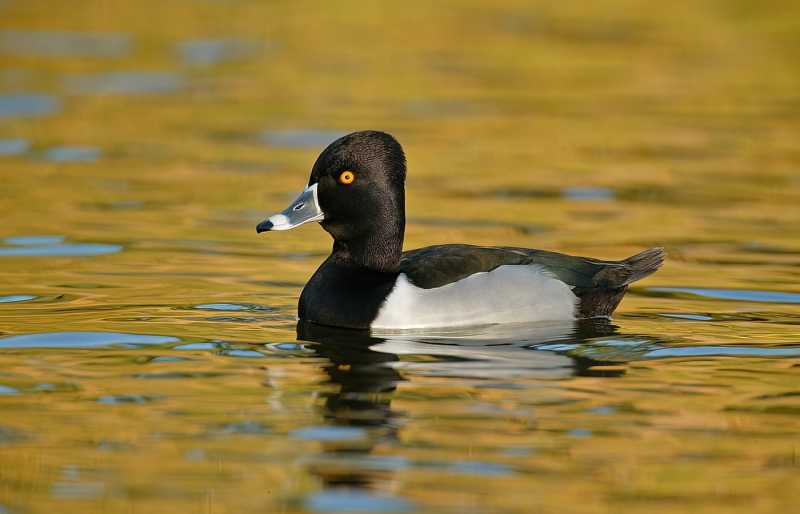
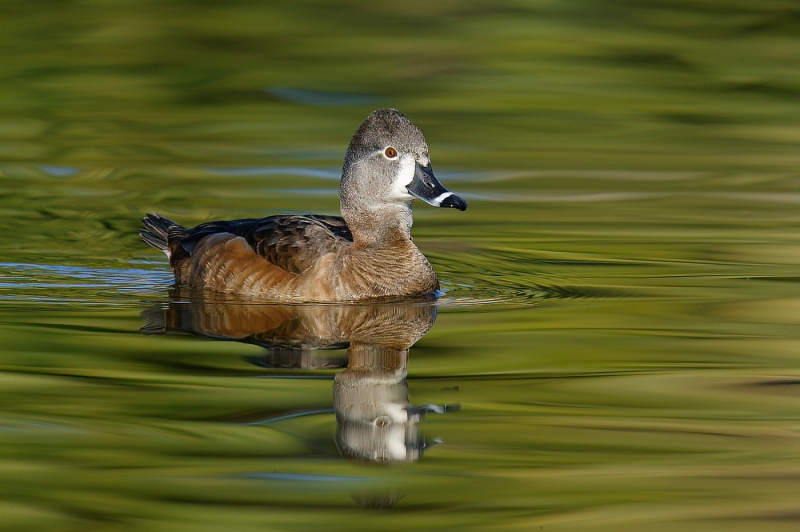
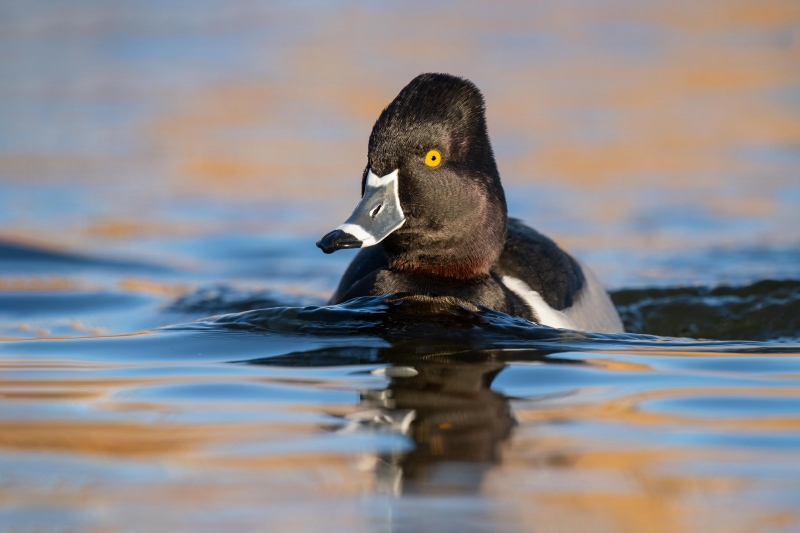
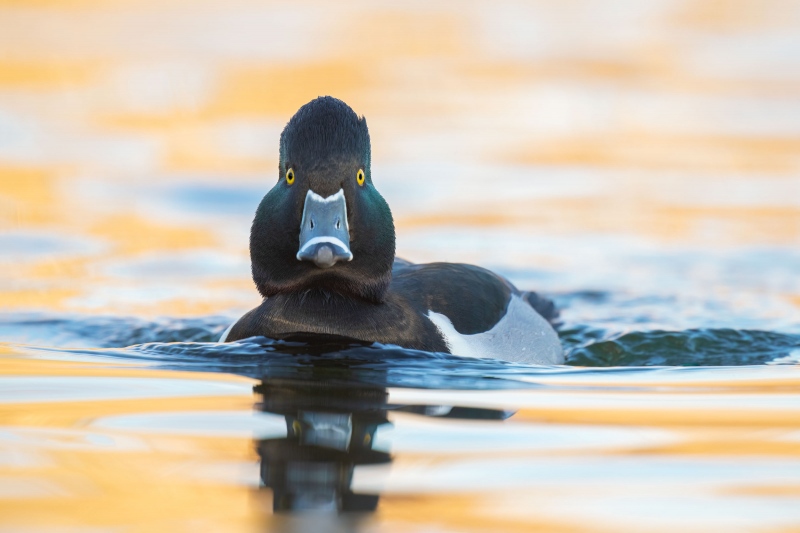
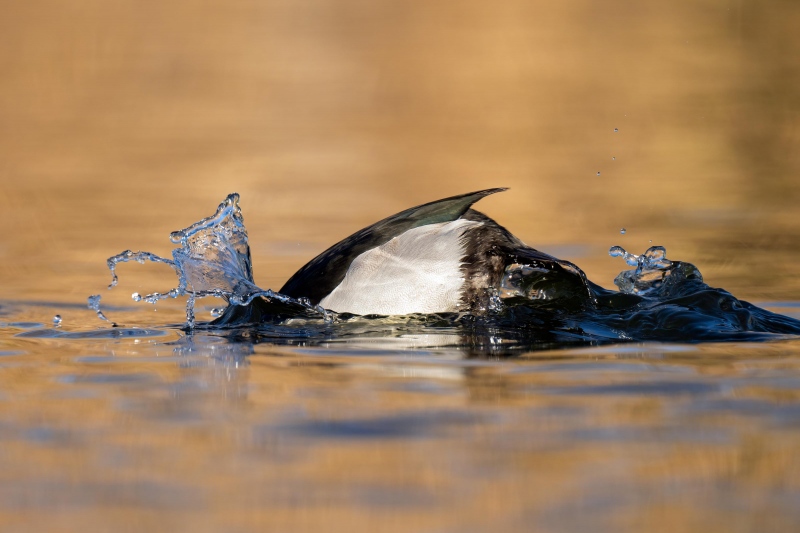
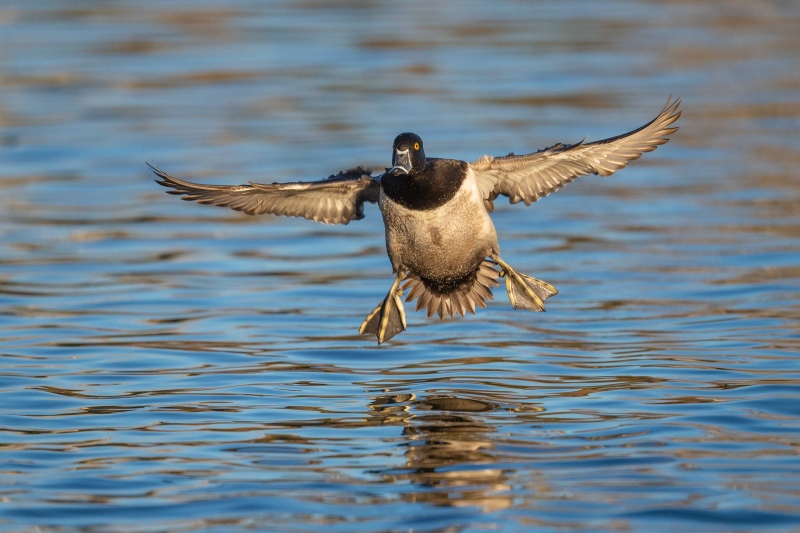
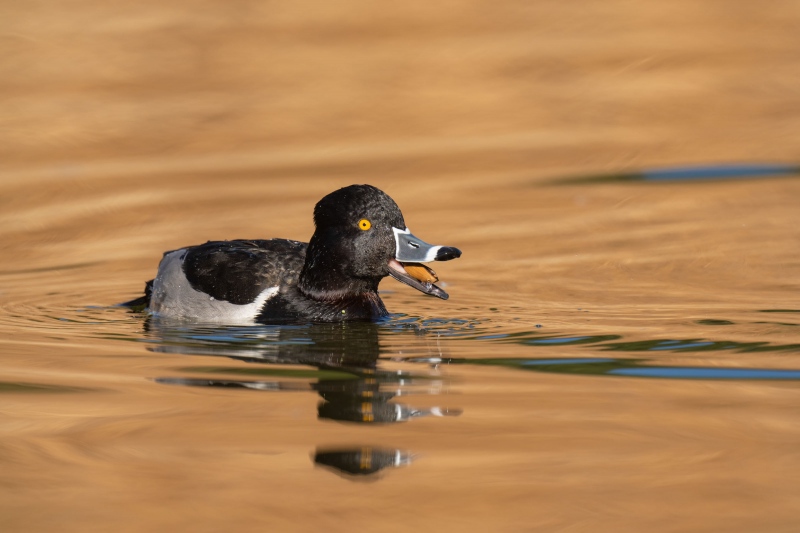
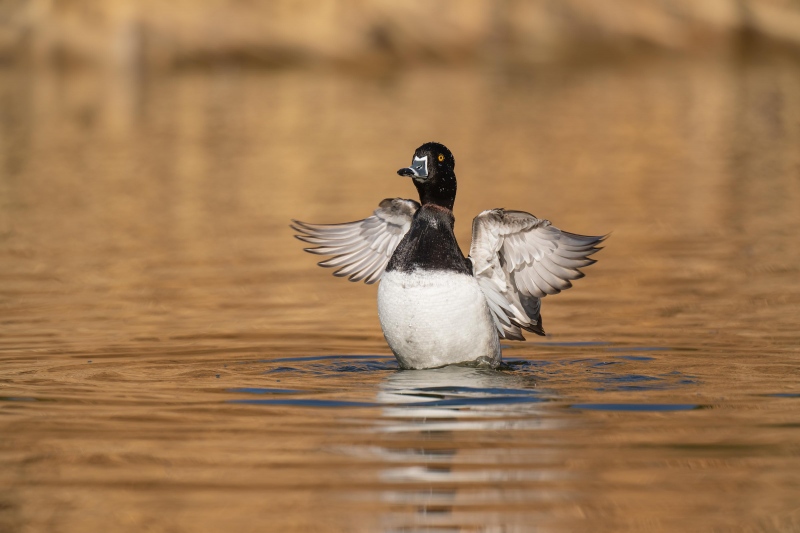
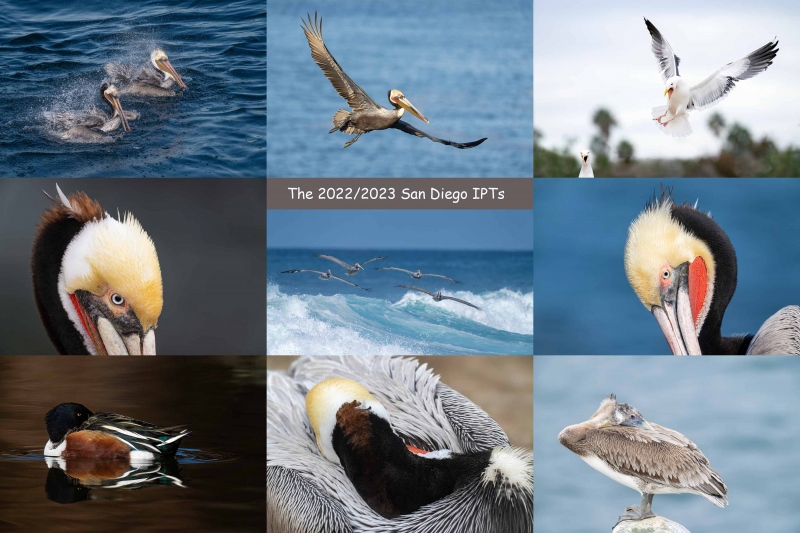
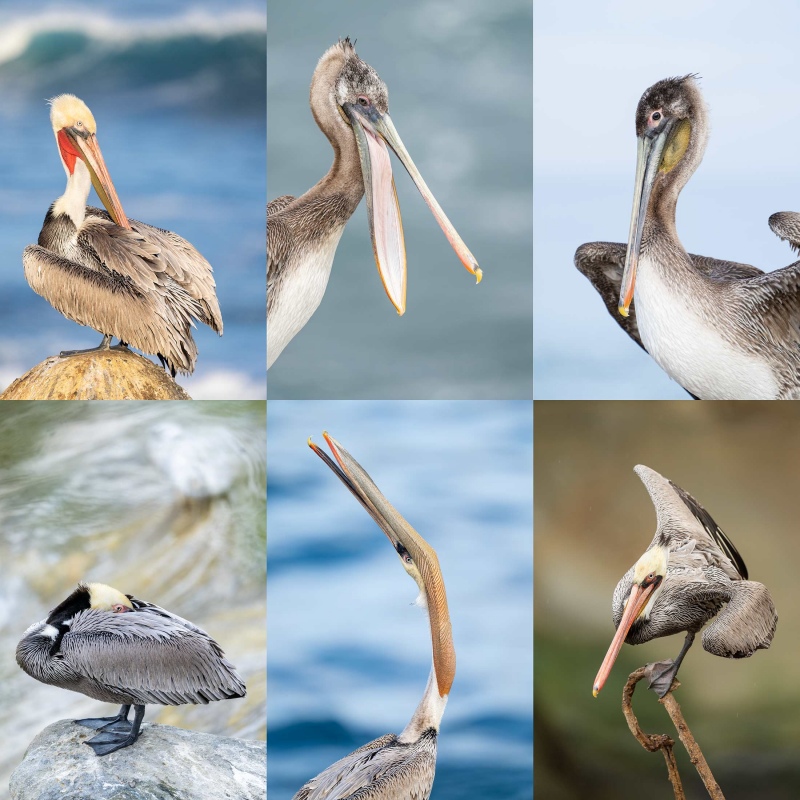
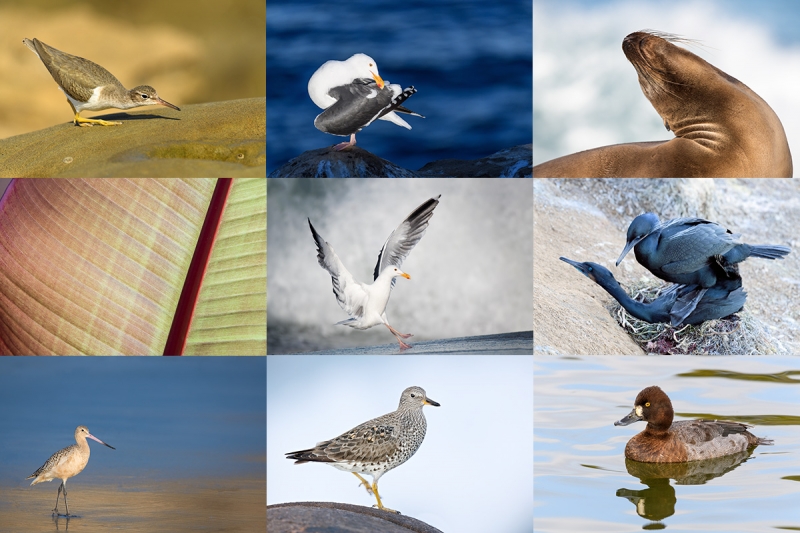

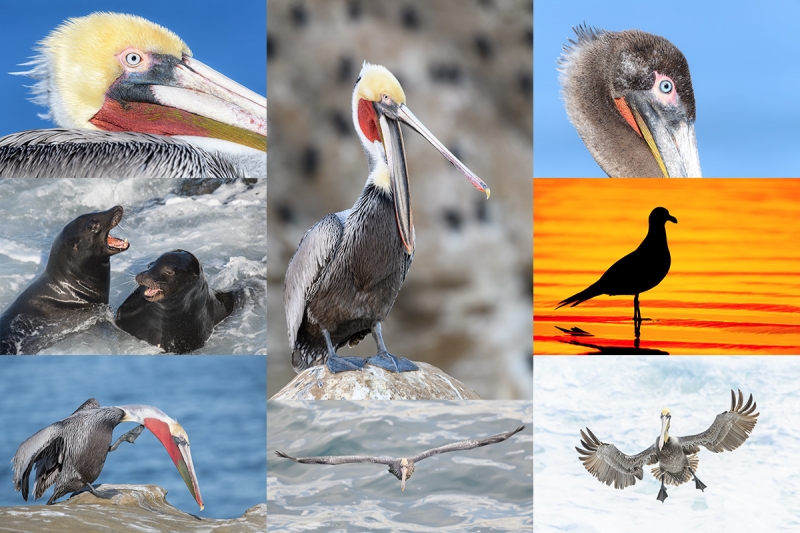














Image #2: The Ring-necked Duck hen floating. To a large extent, I like the soft water that primarily shows the hen’s movement. It’s a peaceful shot, as if you passed her in a canoe.
Hi Guru.
Perhaps in your archive, you might have a few images shot with film SLRs. Could you kindly post some of those?
Thank you in advance and best regards.
Sanjeed
Quazi, Why?
with love, artie
Same reason why you posted the Canon 1DS images.
Rgds.
Sanjeed
Not. I posted the 1Ds images because they filled my needs at the time. You cannot tell anything by looking at a JPEG of a film scan. You would not know how the scan was done, or how the JPEg was created. On occasion, I use JPEGs made from film scans in various slide shows and YouTube stuff, but again, judging their quality is impossible.
with love, artie
I do believe the 1Ds had 45 point autofocus. It only went to the one center point when you were at a max aperture >f/5.6.
Thanks, Ryan. I am pretty sure that you are correct. It was a long time ago for me.
with love, artie
Artie, #4. Reminds me of Prospect Park. Kick-ass duck.
#3 for me is above all the other ones. Water level, sun lighted, blue and orange water, subject looking towards at us.
Image #2, followed closely by #6. Sharpness, light quality, and, for #6, the activity (braking for landing) did it for me.
If it’s landing on water, isn’t it watering? 😉
Thanks, Loren. I am really surprised at how many folks like the lady duck!
with love, a
Torn between #1 and #2. I love the color of the water reflection in #1, almost matching the eye. For #2, the bird and it’s reflection are great. I think #2 wins a close match. And, if the water reflection on #2 was the color of #1, it would be an easy choice. 🙂 All images are great! BTW, I used your R5 guide to setup my body purchased through Bedfords, and it is working GREAT! Thanks again, Artie!
Hey Alan,
Thanks for your kind words. I am glad that you are liking your R5!
with love, artie
Number two. The green water is breathtaking. It almost looks like loosely plaited wool.
Thanks, Margaret. I guess the backgrounds can be more important than the subjects.
with love, artie
Image #2 is my favorite with 6 and 7 right behind. I like the colors in #2 and the lighting on the bird.
Hey Jim, Your thoughtful comments are appreciated.
with love, artie
Image #2 of the hen is a stunner. The subject is lit evenly with warm light, sharpness and exposure appear spot on, it’s posing perfectly and the green water is simply over the top. It is clearly the best of the 8 and illustrates the point that the gear isn’t the most important factor involved in creating great images.
Hey Doc, Thanks for leaving an erudite comment.
with love, artie